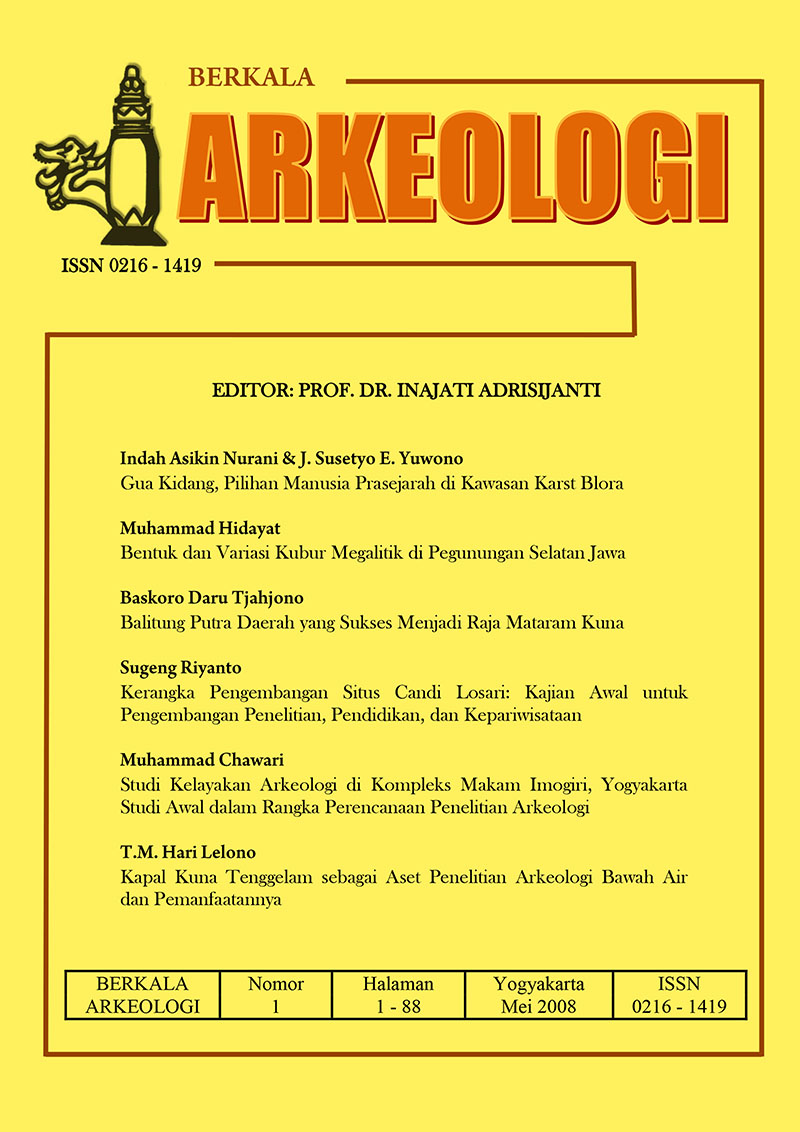KERANGKA PENGEMBANGAN SITUS CANDI LOSARI: KAJIAN AWAL UNTUK PENGEMBANGAN PENELITIAN, PENDIDIKAN, DAN KEPARIWISATAAN
Main Article Content
Abstract
Archaeological research in Losari Temple site also implicates how the site should be developed. There are three frameworks: research framework, educational framework, and tourism framework. Research framework is related to Losari Temple and how its information or its data may support archaeological research or other disciplines. A framework for education is related to how the information may support educational program. In the framework for tourism there are four most important aspects: how to preserve the site, how to present the information, how to manage the access and accomodation, and how to promote the object.
Article Details

This work is licensed under a Creative Commons Attribution-NonCommercial-ShareAlike 4.0 International License.
References
Atmosudiro, Sumijati. 2004. Khasanah Sumberdaya Arkeologi Indonesia: Peluang dan Kendala Pemanfaatannya. Pidato Pengukuhan Jabatan Guru Besar pada Fakultas Ilmu Budaya UGM.
Carman, John. 2002. Archaeology and Heritage, an Introduction. London: Continuum.
Cleere, Henry. 1989. “Introduction: The Rationale of Archaeological Heritage Managementâ€. Henry F. Cleere (ed.) Archaeological Heritage Management in the Modern World. London: Unwin Hyman. pp. 1-19.
Cooper, Chris. 1991. “The Technique of Interpretation†dalam Managing Tourism, S. Medlik (ed.). Oxford: Butterworth-Heinemann Ltd. pp. 224-229.
Davis, Karen Lee. 1997. “Site without Sight: Interpreting Closed Excavation†dalam Presenting Archaeology to the Public. John H. Jameson Jr. (ed.). California: Altamira Press. pp. 84-98.
Gunn, C. A. 1988. Vacationscape: Designing Tourist Regions. New York: Van Nostrand Reinhold.
Haryono, Timbul. 1993. “Metodologi dan Aplikasinya dalam Penelitian Arkeologi†Artefak No. 13 Agustus 1993, pp. 9-14.
Haryono, Timbul. 2003. “Pengembangan dan Pemanfaatan Aset Budaya dalam Pelaksanaan Otonomi Daerahâ€. Makalah disampaikan pada Rapat Koordinasi Kebudayaan dan Pariwisata diselenggarakan oleh Kementrian Kebudayaan dan Pariwisata di Jakarta pada tanggal 25-27 Maret 2003.
Iseminger, William R. 1997. “Public Archaeology at Cahokia†dalam Presenting Archaeology to the Public. John H. Jameson Jr. (ed.). California: Altamira Press. pp.147-155.
MacLeod, Donald G. 1977. “Peddle or Perish: Archaeological Marketing from Concept to Product Deliveryâ€. Michael B. Schiffer & George J. Gumerman (eds.). Conservation Archaeology A Guide for Cultural Resources Management Studies. New York: Academic Press. pp. 63-72.
McManamon, Francis P. & Alf Hatton. 2000. “Introduction: Considering Cultural Resource Management in Modern Societyâ€. Francis P. McManamon & Alf Hatton (eds.) Cultural Resource Management in Contemporary Society, Perspective on Managing and Presenting the Past. London: Routledge.
Renolds, W.H. 1965. “The Role of the Consumer in Image Buildingâ€, dalam California Management Review. Musim Semi. pp. 69-76.
Ross, Glann, F. 1998. Psikologi Pariwisata. Terjemahan Marianto Samosir. Jakarta: Yayasan Obor Indonesia.
Soebadio, Haryati. 1993/1994. â€Arkeologi dan Pengembangan Sosial-Budaya Bangsaâ€. Dalam Proceedings Pertemuan Ilmiah Arkeologi VI. Jakarta: Pusat Penelitian Arkeologi Nasional. pp. 3-13.
Sumanto, 1995. Metodologi Penelitian Sosial dan Pendidikan. Yogyakarta: Penerbit Andi Offset.
Tanudirjo, Daud Aris, et. al., 1993/1994. Laporan Penelitian Kualitas Penyajian Warisan Budaya Kepada Masyarakat: Studi Kasus Manajemen Sumberdya Budaya Candi Borobudur. Yogyakarta: PAU-SS Universitas Gadjah Mada. Tidak terbit
Tjahjono, Baskoro Daru. 2007. Laporan Penelitian Arkeologi Candi Losari, Sebuah Kompleks Candi Hindu di Kawasan Sekitar Borobudur. Tidak terbit.
Young, Peter A. 2002. “Archaeologist as Storyteller†dalam Public Benefit of Archaeology. Barbara J. Little (ed.). Florida: University Press of Florida, pp. 239-243.

